- What is Insomnia
- Statistics on Insomnia
- Risk Factors for Insomnia
- Progression of Insomnia
- Symptoms of Insomnia
- Clinical Examination of Insomnia
- How is Insomnia Diagnosed?
- Prognosis of Insomnia
- How is Insomnia Treated?
- Insomnia Prevention
- Insomnia References
What is Insomnia
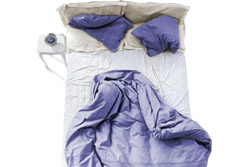
Some research has found that poor sleep quality is caused by an individual being unable to achieve delta or stage 4 sleep, which is the sleep stage that has restorative properties.
 |
For more information, see Sleep Physiology. |
How insomnia is classified
Classification based on the duration of insomnia
Insomnia can be classified based on its duration as either:
- Acute:
- Transient: Lasting a few days;
- Short term: Lasting 3–4 weeks; or
- Chronic: Lasting for more than 1–3 months.
Transient insomnia can be triggered by a number of factors, including:
- Changes to the sleep environment: Physical stimuli (noise, light, movements), an unfamiliar environment;
- A high state of arousal: Due to emotional events, such as grieving, excitement, worry, anxiety, pain and illness;
- Poor sleep hygiene: Irregular sleeping patterns, excessive consumption of agents that delay sleep; and/or
- Short-term disruption of the “body clock”: Induced by rotating shift work or jetlag.
Primary chronic insomnia is thought to occur in individuals that are in a state of hyperarousal. Chronic insomnia is associated with muscle fatigue, hallucinations and mental fatigue. Individuals also report double vision and a feeling of being in slow motion.
There is another less common type of insomnia called cyclical insomnia. Cyclical insomnia results from a lack of balance between sleep and wake cycles. Cyclical insomnia may occur briefly or may be an issue throughout the life of a particular individual. The insomnia may recur at the same time as changes within the body as in disorders of the body clock or premenstrual insomnia.
 |
For more information, see Primary Insomnia.
Classification based on the severity of insomnia
Insomnia can also be categorised based on severity, into:
- Mild;
- Moderate; or
- Severe.
Classification based on the cause of insomnia
Insomnia often occurs at the same time as psychological disturbances and depression. This is known as secondary insomnia (or comorbid insomnia).
Insomnia can also occur in the absence of any other underlying medical conditions – this is known as primary insomnia (or idiopathic insomnia). The main complaint with primary insomnia is difficulty getting to sleep or maintaining sleep. Insomnia can have a major effect on quality of life, productivity and mental health.
Classification based on the type of sleep pattern that is disrupted
There are three different types of sleep patterns of insomnia:
- Onset/early insomnia involves difficulty falling asleep. This type of insomnia is often associated with elevated levels of arousal and can be associated with anxiety disorders. Onset insomnia is defined as taking more than 30 minutes to fall asleep.
- Middle insomnia refers to waking in the middle of the night and difficulty sleeping for long periods. This type of insomnia can often be the result of pain or other illness.
- Terminal/late insomnia occurs in individuals who wake up too early in the morning. Terminal insomnia is common in the elderly, in individuals experiencing depression, and in women going through menopause.
Statistics on Insomnia
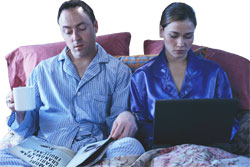
There are over 70 different defined sleep disorders which result in reduced sleep quantity or reduced sleep quality. Of these, the most common and severe sleeping disorders are obstructive sleep apnoea, narcolepsy (excessive daytime sleepiness), periodic limb movement disorders, insomnia, parasomnias (partial arousals during sleep) and circadian rhythm disorders.
5% of the Australian population experience chronic insomnia. Of these, approximately 75% are due to underlying medical and/or psychological conditions (secondary insomnia). The remaining 25% are cases of primary insomnia.
As we age our sleep patterns change, with a larger delay between going to bed and the onset of sleep, and the quality of sleep is reduced. The elderly are more easily aroused from sleep. The combined effect of all of these factors is that the elderly are much more likely to suffer from insomnia.
There is a higher overall prevalence of insomnia in women compared to men. Studies have shown than in the 20–29 year old age bracket the incidences of insomnia were ~3% in women and ~4% in men, where in those over 75 years of age the incidence was ~35% in women but only ~12% in men.
Risk Factors for Insomnia
There are many different factors and medical conditions that can predispose a person to experiencing insomnia. In these cases, insomnia occurs as a secondary effect or consequence of the medical condition, so is secondary insomnia. This is distinct from primary insomnia, where the primary complaint is the insomnia itself.
Risk factors for chronic insomnia include:
- Physical illness:
- Rheumatoid arthritis;
- Hyperactive thyroid;
- Brain lesions or traumatic brain injury (i.e. Parkinson’s disease and stroke);
- Pain;
- Nocturnal angina;
- Nocturnal breathlessness (including asthma);
- Nighttime urination;
- Gastric refluxes; and/or
- Peptic ulcers.
- Psychological and cognitive causes:
Substances that promote insomnia:
- Alcohol;
- Beta-blockers;
- Withdrawal from medications;
- Caffeine;
- Nicotine; and/or
- Selective serononin reuptake inhibitors (a class of antidepressants).
- Sleep disorders that result in insomnia:
- Obstructive sleep apnoea;
- Restless leg syndrome;
- Periodic limb movement disorder;and/or
- REM sleep disorders.
- Circadian rhythm disruptions:
- Shift work; and/or
- Jet lag.
- Genetic risk factors for insomnia:
- Being female; and/or
- Hereditary component: Twin studies indicate that genetics account for ~30% of the difference in sleep quality and ~40% of the difference in sleep patterns.
Behavioural and/or lifestyle risk factors for insomnia:
Symptoms of Insomnia

- Excessive daytime tiredness;
- Impaired daytime performance;
- Muscle aches: Common and often more severe in the limbs. Muscle aches can also precipitate neck and head aches. The aches are likely a result of the increased muscle tension, since the muscles miss out on the normal inhibition of motor activity that occurs during sleep.
- Increased risk of falls (particularly in the elderly);
- Hypertension (high blood pressure);
- Poor immune system function;
- Susceptibility to obesity;
- Increased risk of cardiovascular disease; and
- Increased risk of diabetes.
The psychological side effects of insomnia include:
- Loss of concentration;
- Deterioration of memory;
- Irritability and mood disturbances;
- Anxiety and depression;
- Loss of motivation;
- Fear regarding long-term consequences of insomnia;
- Destructive ruminating thoughts at bedtime: These often centre on a fear of not sleeping or frustration and anxiety regarding the insomnia.
An elevated risk of daytime accidents in the workplace or while driving is also a consequence of impaired sleep.
Clinical Examination of Insomnia

The doctor will take a detailed clinical history from the individual and may interview relatives or caregivers to get a better understanding of the individual’s sleep patterns, function during the daytime, substance use and snoring. This information may be beneficial for understanding the nature of the insomnia and may help to tailor various interventions to try to reduce the insomnia.
The doctor may ask the individual to keep a detailed sleep diary. This will involve writing down substance use, the times of going to bed, nighttime awakenings, nightmares, total amount of time spent sleeping and how the individual feels upon waking in the morning. Other information to include is whether particular foods or alcohol use tend to make the insomnia worse, and the use of any medications. A sleep log of this nature can help to identify whether the patient has early, middle or late insomnia.
Other more specialised tests can be conducted if the individual does not respond well to medication and/or behavioural adjustments. A polysomnography is a test that measures the time taken to fall asleep, and can measure this duration multiple times if an individual wakes frequently. This test is particularly useful in individuals that are suspected of experiencing sleep apnoea and periodic limb movement disorder. An activity monitor can also be worn on the wrist that records movement. The absence of movement over an extended period indicates that the individual is asleep.
In a small percentage of cases where structural changes in the brain are suspected, neuroimaging such as a MRI or CT can be performed.
How is Insomnia Diagnosed?
A diagnosis of chronic insomnia is made if an individual experiences problems failing asleep, poor sleep quality or too little sleep, at least 3 times a week for at least 1 month. In addition, this lack of sleep must be associated with:
- At least one of the following complaints:
- Difficultly initiating or maintaining sleep;
- Poor quality sleep;
- Trouble sleeping despite opportunity and circumstances for sleep; and/or
- Waking up too early;
- And at least one of the following types of daytime impairment related to sleep:
- Attention, concentration or memory impairment;
- Concerns or worries about sleep;
- Daytime tiredness;
- Errors at work or while driving;
- Fatigue or malaise;
- Gastrointestinal symptoms;
- Lack of motivation;
- Mood disturbances;
- Social dysfunction; and/or
- Tension headaches.
Prognosis of Insomnia
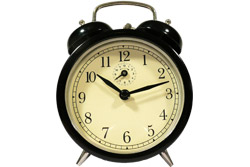
Cognitive behavioural therapy and improved sleep hygiene are very effective as primary interventions for alleviating insomnia. If these treatment options are not effective, then pharmacological agents may be considered. In general, insomnia can be treated well in the majority of people.
How is Insomnia Treated?

Treatment options for chronic insomnia are divided into pharmacological and non-pharmacological interventions.
Non-pharmacological interventions
Cognitive behavioural therapy
Cognitive behavioural therapy addresses an individual’s incorrect beliefs and attitudes towards sleep (e.g. unrealistic expectations, misconceptions). This approach aims to identify dysfunctional beliefs and attitudes about sleep and replace them with more realistic attitudes. This type of verbal intervention may in some cases be sufficient to reduce an individual’s fear of insomnia. Sleep and sleep hygiene education are also an important aspect of this approach. Techniques include reattribution training (e.g. goal setting and planning appropriate coping responses), decatastrophising, and attention shifting.
Cognitive behavioural therapy and other behavioural therapies, including relaxation therapy and sleep restriction, have been shown to produce reliable and long-lasting improvements in individuals suffering with chronic insomnia.
Relaxation therapy
Relaxation therapy includes tensing and relaxing different muscle groups, meditation and hypnosis.Progressive relaxation of muscle groups to decrease somatic arousal, and attention focusing techniques such as meditation to reduce pre-sleep cognitive arousal, are both useful for early and middle insomnia. Diligent practicing of these techniques over a period of 2–4 weeks is required before any improvement in sleep is seen.
Sleep restriction therapy
This technique consists of reducing the amount of time spent awake in the bed. This therapy begins by inducing a state of mild sleep deprivation to increase the individual’s ability to fall a sleep and stay asleep. Bedtime is set 15–35 minutes earlier per week than was recorded in the sleep log. The wakeup time remains unchanged. The aim of this process is to induce rapid sleep onset and sleep maintenance of 85% of the time. This process takes 4–6 weeks to have an effect on sleep.6
Other behavioural modifications to improve sleep can be summarised as sleep hygiene. These modifications include:
- Moderate-intensity level exercise;
- Avoiding stimuli prior to bed;
- Restriction of the bed and bedroom to sleep and intimacy;
- Reducing bodyweight in obese and overweight individuals; and
- Quitting smoking.
 |
For more information, see Sleep Hygiene.
Pharmacological interventions
After front-line treatment with behavioural modifications and other non-pharmacological therapies, your doctor will advise if any of the following pharmaceuticals may be applicable to your particular situation.
Prolonged-release melatonin
Melatonin is a key regulator of the sleep-wake cycle. It is the intrinsic signal of darkness in the body, and resets the body clock and physiologically promotes and regulates sleep.
Prolonged-release melatonin (Circadin) is a slow release form of melatonin that mimics the release of naturally occurring melatonin in the body. Prolonged release melatonin is used to improve sleep quality and morning alertness, particularly in the elderly. In clinical trials there is no evidence of dependency or withdrawal symptoms; and no rebound insomnia after the medication is stopped (i.e. the severity of insomnia after stopping the medication is no worse than the insomnia before treatment started).
Benzodiazepine hypnotics
Benzodiazepines function as GABA receptor antagonists to increase sleep time and improve sleep duration. Drugs with shorter half-lives are preferred to minimise residual drowsiness. A single dose of temazepam (e.g. Normison, Temaze, Temtabs) or oxazepam (e.g. Alepam, Murelax, Serepax) can have effects well into the following day, and nitrazepam (e.g. Alodorm, Mogadon) even more so.
While inducing unconsciousness, benzodiazepines actually worsen sleep quality as they promote light sleep and decrease time spent in deep REM sleep. Tolerance and dependence can also occur with prolonged use; thus, benzodiazepines are most useful for alleviating insomnia in the short term.
Withdrawal can be associated with anxiety, depression, nausea, rebound insomnia, nightmares and impaired memory. Gradual drawing back of the dose alone is ineffective in achieving long-term cessation of benzodiazepine use. However, in 70% of cases, successful discontinuation can be achieved by combining tapering of the dose and cognitive behavioural therapy.
Nonbenzodiazepine hypnotics
This newer class of drugs selectively bind to type-1 benzodiazepine receptors. Unlike benzodiazepines, nonbenzodiazepines have minimal impact on sleep stages and no REM sleep rebound. Nonbenzodiazepines undergo clearance by the liver, and doses should be reduced in the elderly with impaired liver function.
Zopiclone (e.g. Imovane, Imrest) has a bitter taste, which is its most common adverse effect. Zolpidem (e.g. Dormizol, Somidem, Stildem, Stilnox, Zolpibell) can cause hallucinations in a small percentage of people. Your doctor will stop treatment should these occur.
Barbiturates
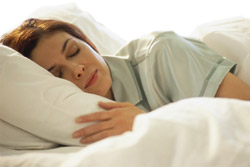
Opiates
Opiates interrupt sleep and decrease REM and stage 2 sleep. Due to the sedative and analgesic properties of opiates, these can be used with careful monitoring in individuals experiencing pain-associated insomnia.
Antidepressants
Some antidepressants produce sedation by blocking acetylcholine, noradrenaline and serotonin receptors. Antidepressants reduce the latency to sleep onset and wakefulness during sleep. They also increase total sleep time and sleep quality, but reduce REM sleep.
Hormone therapy (menopause-related insomnia)
Insomnia caused by menopause can often be treated by oestrogen replacement treatment. The duration of stage 3 and 4 deep non-REM sleep is increased. Improvement of insomnia is most likely if hormone replacement relieves the hot flushes.
Antihistamines
Nearly 25% of individuals who experience insomnia use over-the-counter medications to aid sleep. Use of antihistamines should be discouraged since they are minimally effective at inducing sleep, reduce sleep quality and cause drowsiness.
Herbal and dietary supplements

More Information
 |
For more information about sleep, including how much is good for you, tips for getting more sleep, and sleep disorders, as well as some useful videos, see Sleep. |
Insomnia Prevention
Insomnia can be prevented in some cases through good sleep hygiene, including simple but effective lifestyle and dietary modifications.
 |
For more information, see Sleep Hygiene. |
Insomnia References
-
Lee-Chiong TL. Sleep Medicine: Essentials and review. Oxford: Oxford University Press; 2008. Available from: [Book]
- Shneerson JM. Sleep Medicine: A guide to sleep and its disorders (2nd edition). Oxford: Blackwell Publishing; 2005.
- Ramakrishnan K, Scheid DC. Treatment options for insomnia. Am Fam Physician. 2007;76(4):517-26. Available from: [Abstract | Full text]
- Sleep Health Australia. Wake up Australia: The value of healthy sleep [online]. Barton, ACT: Access Economics; October 2004 [cited 15 June 2010]. Available from: [URL Link]
- Woodward MC. Managing insomnia in older people. J Pharm Pract Res. 2007;37(3):236-41. Available from: [Full text]
- International Classification of Sleep Disorders: Diagnostic and coding manual (2nd edition). Westchester, IL: American Academy of Sleep Medicine; 2005. Available from: [Book]
- Tiller JWG. The management of insomnia: An update. Aust Prescr. 2003;26(4):78-81. Available from: [Full text]
- Grunstein R. Insomnia diagnosis and management. Aust Fam Physician. 2002;31(11):995-1000. Available from: [Abstract | Full text]
- Holbrook AM, Crowther R, Lotter A, et al. The diagnosis and management of insomnia in clinical practice: A practical evidence-based approach. CMAJ. 2000;162(2):216-20. Available from: [Abstract | Full text]
- Ringdahl EN, Pereira SL, Delzell JE Jr. Treatment of primary insomnia. J Am Board Fam Pract. 2004;17(3):212-9. Available from: [Abstract | Full text]
- Edinger JD, Wohlgemuth WK, Radtke RA, et al. Cognitive behavioral therapy for treatment of chronic primary insomnia: A randomized controlled trial. JAMA. 2001;285(14):1856-64. Available from: [Abstract | Full text]
- Ebben MR, Spielman AJ. Non-pharmacological treatments for insomnia. J Behav Med. 2009;32(3):244-54. Available from: [Abstract]
- Centre for Clincal Interventions. Progressive muscle relaxation [online]. Northbridge, WA: Western Australian Government Department of Health; 2007 [cited 14 June 2010]. Available from: [PDF File]
- Montgomery P, Dennis J. Cognitive behavioural interventions for sleep problems in adults aged 60+. Cochrane Database Syst Rev. 2003;(1):CD003161.
- Wade A, Downie S. Prolonged-release melatonin for the treatment of insomnia in patients over 55 years. Expert Opin Investig Drugs. 2008;17(10):1567-72. Available from: [Abstract]
- Scharf MB, Roth T, Vogel GW, Walsh JK. A multicenter, placebo-controlled study evaluating zolpidem in the treatment of chronic insomnia. J Clin Psychiatry. 1994;55(5):192-9. Available from: [Abstract]
- Buscemi N, Vandermeer B, Friesen C, et al. Manifestations and management of chronic insomnia in adults. Evid Rep Technol Assess (Summ). 2005;(125):1-10. Available from: [Abstract | Full text]
- Kupfer DJ, Reynolds CF 3rd. Management of insomnia. N Engl J Med. 1997;336(5):341-6. Available from: [Abstract]
- Centre for Clinical Interventions. Calming technique [online]. Barton, ACT: Western Australian Government Department of Health; October 2003 [cited 14 June 2010]. Available from: [PDF File]
-
Wade A, Downie S. Prolonged-release melatonin for the treatment of insomnia in patients over 55 years. Expert Opin Investig Drugs. 2008;17(10):1567-72. Available from: [Abstract]
-
Lemoine P, Nir T, Laudon M, Zisapel N. Prolonged release melatonin improves sleep quality and morning alertness in insomnia patients aged 55 years and older and has not withdrawal effects. J Sleep Res. 2007;16(4):372-80. Available from: [Full text]
- Assessment report for Circadin. Procedure No. EMEA/H/C/695. London: European Medicines Agency; 2007.
- Luthringer R, Muzet M, Zisapel N, Staner L. The effect of prolonged-release melatonin on sleep measures and psychomotor performance in elderly patients with insomnia. Int Clin Psychopharmacol. 2009;24(5):239-49. Available from: [Abstract]
Drugs/Products Used in the Treatment of This Disease:
- Circadin Prolonged Release Tablets (Melatonin)
- Cipramil (Citalopram hydrobromide)
- Imovane (Zopiclone)
- Phenergan (Promethazine hydrochloride)
- Prozac (Fluoxetine hydrochloride)
- Temaze (Temazepam)
All content and media on the HealthEngine Blog is created and published online for informational purposes only. It is not intended to be a substitute for professional medical advice and should not be relied on as health or personal advice. Always seek the guidance of your doctor or other qualified health professional with any questions you may have regarding your health or a medical condition. Never disregard the advice of a medical professional, or delay in seeking it because of something you have read on this Website. If you think you may have a medical emergency, call your doctor, go to the nearest hospital emergency department, or call the emergency services immediately.

 Substances that promote insomnia:
Substances that promote insomnia:
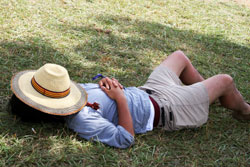 Behavioural and/or lifestyle risk factors for insomnia:
Behavioural and/or lifestyle risk factors for insomnia:






